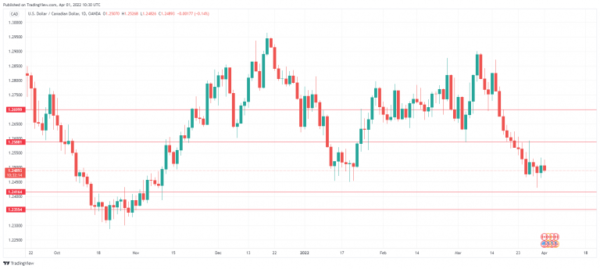The Canadian dollar has posted small gains, trading just below the symbolic 1.25 line in the European session. We could see stronger movement from the currency when US nonfarm payrolls are released later today.
The month of March has brought plenty of turbulence to the financial markets, highlighted by the Ukraine-Russia war, which shows no signs of ending anytime soon. The war has caused a massive humanitarian crisis and ruptured relations between Moscow and the West, and clearly, such a grim landscape has taken its toll on investor risk appetite.
The Canadian dollar is sensitive to risk, but gained ground in March, as USD/CAD fell by 1.28%. The currency has managed to remain in demand despite heightened risk apprehension, thanks to the Canadian economy, which is a major exporter of oil and other commodities. The ongoing surge in commodity prices has boosted the Canadian economy as well as the Canadian dollar, which earlier this week hit its highest level since November 2021.
Canada’s economy rose by a modest 0.2% in January. GDP has now expanded for the eighth month in a row, but the recovery has been hampered by the Covid pandemic. Some parts of the country are experiencing a spike in Omicron cases, which appears to be a sixth wave of Covid. If the government responds by tightening health restrictions, the move will likely dampen economic activity.
US nonfarm payrolls could affect Fed policy
All eyes are on US nonfarm payrolls, with a consensus estimate of 490 thousand jobs. There is growing talk that the Federal Reserve could resort to salvos of 50 basis points in order to contain hot inflation, and today’s release could have a significant impact on the size of upcoming rate hikes – a print of 600K or higher will bolster the arguments for that the economy is strong enough to withstand a series of 50-base point hikes.
USD/CAD Technical
- USD/CAD faces resistance at 1.2588 and 1.2699
- There is support at 1.2416 and 1.2355















